Diplomatic Bluebook 2020
Chapter 2
Japan's Foreign Policy that Takes a Panoramic Perspective of the World Map
3 China / Mongolia, etc.
(1) China
A The Situation in China
(A) Domestic affairs
The second session of the 13th National People's Congress was held in March. Amid the recent economic slowdown in China and the effects of trade friction between the U.S. and China, Premier Li Keqiang spoke about “complicated and challenging domestic and international environment,” “new downward pressure on the economy,” and “China-U.S. economic and trade frictions having an adverse effect on the production and business operations of some companies and on market expectations” in the Government Work Report. He announced a proactive fiscal policy and a prudent monetary policy including a GDP growth target for 2019 of 6.0%-6.5% (growth in 2018 was 6.7% with a target of around 6.5%), large-scale tax cuts, reduction of corporate contributions to social insurance, the expansion of local government bonds, and the expansion of investment in infrastructure. He also announced to work faster to make China strong in manufacturing, advance economic reforms to implement a system of punitive compensation for intellectual property infringements, further implement the military-civilian integration strategy, speed up efforts to make innovations in defense related science and technology, and increase the national defense budget by 7.5% year-on-year.
A military parade was held on October 1 to commemorate the 70th anniversary of the founding of the People's Republic of China. It was the largest military parade under the Xi Jinping administration, with the participation of around 15,000 soldiers. In his speech, President Xi Jinping stated that no force can shake the status of the great nation of China and continued efforts should be made to achieve the Chinese Dream of national rejuvenation.
The fourth plenary session of the 19th CPC (Communist Party of China) Central Committee was held later that month from the 28th to the 31st. The session emphasized “upholding the centralized and unified leadership of the CPC” as “notable strengths of China's state and governance system” and also set the policy of upholding and maintaining systems in various fields, such as guidance from the CPC, law-based governance, administration, the economy, culture, livelihood, security, the environment, military, “one country, two systems” and the unification of China, diplomacy, and oversight of the Party and the state (anti-corruption).
Large-scale protests occurred in Hong Kong when the local government submitted an amendment to the extradition bill to the Legislative Council in March that would broaden its application to countries and regions including mainland China. In June, organizers announced that a protest of two million people took place. Even after the Hong Kong Government withdrew the bill, the protesters issued five demands that included universal suffrage, and continued to clash with the police.
In Macau, a ceremony was held on December 20 to mark the 20th anniversary of the handover of Macau and to inaugurate its Chief Executive, Ho Iat Seng. President Xi Jinping attended the ceremony and lauded the success of “one country, two systems” in Macau in his speech.
With respect to the social situation, Chinese authorities continue to severely clamp down on human rights activists and intellectuals, as well as ethnic minorities such as the Uyghurs. There is a growing concern in the international community about the state of human rights in China.
(B) Economy
The real GDP growth rate in 2019 increased 6.1% year-on-year, and total trade value decreased 1.0% year-on-year, which shows a slowdown in the recovery of China's economy. Due to the effects of managing issues of excess production capacity and excess debt, and trade and investment between the U.S. and China, the slowing of growth in domestic demand (consumption, fixed asset investment) has become visible. The impact of trade and investment issues between the U.S. and China can also be seen in financial affairs, and stocks on the Shanghai Stock market rose 24% compared to the start of the year on the announcement of an agreement in “Phase One” talks between China and the U.S. in December. Regarding the foreign exchange rate, the U.S. designated China as a “currency manipulator” in response to the yuan falling to seven yuan per dollar in August. Following additional U.S.-China trade tariffs, the yuan fell against the US dollar, dropping to 7.1 yuan to the US dollar, but with the announcement of the agreement in “Phase One” talks between China and the U.S. in December, the yuan rose to 6.9 yuan to the US dollar (at the beginning of the year it had been 6.7 yuan to the US dollar). As a measure to support the economy, the Chinese Government moved up its announcement to local governments of the limit of 1 trillion yuan for the issuance of special local government bonds for 2020 (47% of the new issuance limit for 2019), and called for early investment in concrete investment projects such as infrastructure. Regarding external economic policy, China advanced the deregulation of its financial industry with measures to open the domestic market, such as passing the Foreign Investment Law and announcing the acceleration of the removal of restrictions on foreign ownership of securities companies and life insurance companies by 2020.
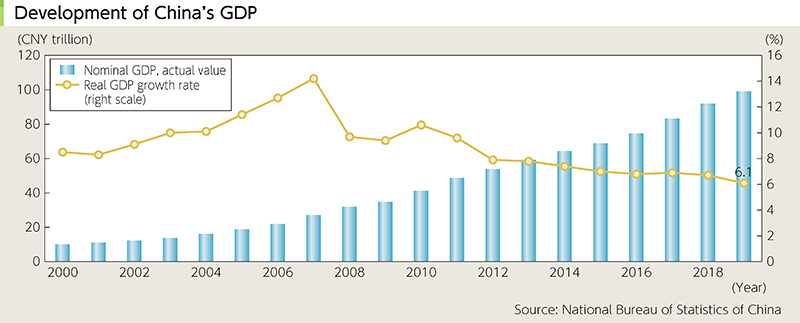
The Central Economic Work Conference held in December offered a harsher view of the current economic situation than last year, and gave top priority to 2020, the target year for promoting the comprehensive completion of a moderately prosperous society and the final year of the 13th Five Year Plan. In addition, the Conference adhered to the theme of stability couching it in the basic policy of realizing the “six stabilities” (employment, finance, foreign trade, foreign investment, domestic investment, and market expectations), escaping poverty, and promoting high-quality development.
Due to the impact of the spread of the novel coronavirus disease, consumption, production, and investment from January-February 2020 saw negative growth for the first time since the statistics were released. Business sentiment in February was the worst for both manufacturing and non-manufacturing firms. The unemployment rate was 6.2%, the worst since the data had been made available, showing the magnitude of the impact of the novel coronavirus pandemic on the Chinese economy.
In order to manage the party and administration stably, it is necessary to ensure constant economic growth while handling all domestic and external issues, and it is worth paying attention to the trends of China's future economic and financial policies.
(C) Foreign Policy
In 2019, China invited leaders of various countries to events, such as the Second Belt and Road Forum for International Cooperation (April) and the 2nd China International Import Expo (November) where it announced policies on high quality Belt and Road construction and the further opening of markets.
Tensions in U.S.-China relations increased in May as both sides urged additional tariff measures. During the G20 Osaka Summit in June, the U.S. and China held a summit meeting and agreed to continue the negotiations. Although the negotiations subsequently faced difficulties, and new additional tariff measures were implemented in September, both the U.S. and China announced that they reached a “Phase One Agreement” on December 13, and worked toward signing the agreement. The U.S. and China are the first and second largest economies in the world, respectively. Establishing stable economic relations between them is directly linked to sustainable economic growth not only in Japan but also in the world as a whole. Japan will continue monitoring future developments.
(D) Military Affairs and Security
China has been increasing its defense expenditures about 51-fold over the past 30 years, but the breakdown of the budget and the intention behind the increase have not been disclosed sufficiently. Under such circumstances, China is extensively and rapidly enhancing and modernizing its military power centered on its nuclear and missile capabilities and naval and air forces. In doing so, it is placing importance on ensuring its superiority in new domains of outer space, cyberspace, and electromagnetic waves. China's expansion of military capability lacking transparency, unilateral actions to change the status quo in the East China Sea and South China Sea, and the expansion and increased vigor of its military activities are common concerns in the region and international community. China has been demonstrating a proactive stance in continuing to take an active part in United Nations PKOs as well as providing various kinds of humanitarian aid and disaster support, etc.
At the 19th Party Congress (2017), President Xi Jinping stated that China would transform its armed forces into a world-class military by the middle of this century. In recent years, China has grown to have a great influence on the international community, not only politically and economically, but also militarily. To dispel any fears of China, there is a pressing need for China to increase transparency regarding its national defense policies and military power through specific and accurate disclosure of information. Japan intends to further promote mutual trust in Japan-China relations through dialogue and people-to-people exchanges, including the Japan-China Security Dialogue, while cooperating with other countries. Japan also intends to urge China to improve its transparency and encourage its positive involvement in the international order based on the rule of law.
B Japan-China Relationship
(A) Bilateral Relations: General
The relationship with China, the neighboring country across the East China Sea, is one of Japan's most important bilateral relationships, and the two countries have close economic relations, as well as people-to-people and cultural exchanges. Carrying on from 2018, 2019 saw active high-level dialogues including Summit Meetings and Foreign Ministers' Meetings, and was a year that took relations to a new stage toward “a new era of Japan-China relations.”
In 2019, reciprocal visits were realized by Prime Minister Abe and President Xi Jinping. In June, President Xi Jinping attended the G20 Osaka Summit, visiting Japan as president for the first time in about nine years. At the Japan-China Summit Meeting, the two leaders confirmed that Japan-China relations have returned to a normal track through reciprocal visits by the leaders in 2018, and that there have been new developments in the relations. They also shared their determination to carve out “a new era of Japan-China relations.” The two leaders shared the view on enhancing reciprocal visits and dialogues at a high level, including at the summit level, in order to have constant and close communications as eternal neighboring countries. As an important next step to this end, Prime Minister Abe, on behalf of the Government of Japan, invited President Xi to pay a state visit to Japan in the spring of 2020, and President Xi accepted the invitation in principle.
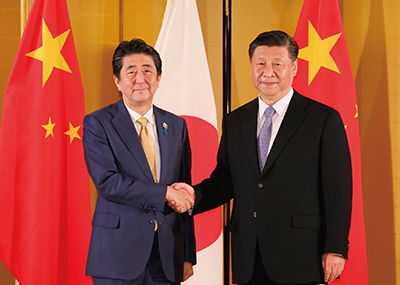 Japan-China Summit Meeting with President Xi Jinping (June 27, Osaka; Photo: Cabinet Public Relations Office)
Japan-China Summit Meeting with President Xi Jinping (June 27, Osaka; Photo: Cabinet Public Relations Office)Prime Minister Abe visited China to attend the Eighth Japan-China-ROK Trilateral Summit in December. During his summit meeting with President Xi Jinping, the two leaders shared the view on continuing to work together to ensure a smooth and meaningful state visit to Japan by President Xi next spring. Prime Minister Abe stated that Japan and China together have a significant responsibility toward peace, stability, and prosperity of the region and the world, and expressed his desire to send out a clear message domestically and internationally of their intention to fulfill this responsibility. In addition, Prime Minister Abe wished that the two countries can demonstrate their determination to continue “ceaseless exchanges,” based on the need to strengthen and firmly establish reciprocal visits and dialogues at the high level, ensuring that the current momentum for improving and deepening Japan-China relations is not temporary. During the Japan-China Summit Meeting with Premier Li Keqiang of the State Council, the premier reflected on how relations have returned to a normal track through reciprocal visits by the leaders in 2018, and shared his determination to carve out “a new era of Japan-China relations” in advance of President Xi Jinping's visit to Japan in the spring of 2020.
 Japan-China Summit Meeting with Premier Li Keqiang (December 24, Chengdu, China; Photo: Cabinet Public Relations Office)
Japan-China Summit Meeting with Premier Li Keqiang (December 24, Chengdu, China; Photo: Cabinet Public Relations Office) Japan-China Summit Meeting with President Xi Jinping (December 23, Beijing, China; Photo: Cabinet Public Relations Office)
Japan-China Summit Meeting with President Xi Jinping (December 23, Beijing, China; Photo: Cabinet Public Relations Office)Additionally, a Japan-China Summit Meeting was held in November with Premier of the State Council Li Keqiang during the ASEAN-related Summit Meetings.
In March 2020, regarding the state visit of President Xi Jinping, Japan and China shared the view that top priority must be given to preventing the spread of the novel coronavirus disease, and that both sides need to prepare adequately to ensure President Xi's state visit is fully successful. They decided to reschedule the state visit to a time that is convenient for both.
Reciprocal visits by the foreign ministers of Japan and China were also held in 2019 as in the previous year. In April, Foreign Minister Kono visited China. Both sides exchanged views on bilateral relations, and regional and international situations, and shared the view to cooperate with each other ahead of the G20 Osaka Summit in June with the shared understanding that 2019 will be an important year for the development of bilateral relations. In November, State Councilor and Foreign Minister Wang Yi visited Japan to attend the G20 Aichi-Nagoya Foreign Ministers' Meeting, and held a foreign ministers' meeting with Foreign Minister Motegi. At the meeting, Japan and China signed the Agreement Between the Government of Japan and the Government of the People's Republic of China on Cooperation in Animal Health and Quarantine (Japan-China Agreement on Animal Health and Quarantine), which served as an important step for lifting the ban on Japanese beef and other exports to China. In addition, regarding dialogues between diplomatic authorities, the two sides shared the view on preparing the annual plan for exchanges and cooperation in 2020 and on continuing to hold further dialogues. The First Japan-China High-Level People-to-People and Cultural Exchange Dialogue (which was agreed to be established within the year at the June Japan-China Summit Meeting), was also held in November on the occasion of State Councilor and Foreign Minister Wang Yi's visit to Japan. Furthermore, continuous dialogues were held between the foreign ministers of Japan and China by seizing various opportunities including in June (the Japan-China foreign ministers' telephone call), August (the ASEAN-related Foreign Ministers' Meetings and the Ninth Japan-China-ROK Trilateral Foreign Ministers' Meeting), September (the United Nations General Assembly), and December (Prime Minister Abe's visit to China).
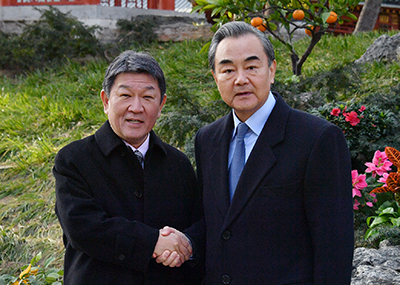 Japan-China Foreign Ministers' Meeting
Japan-China Foreign Ministers' Meeting (December 25, Beijing, China)
China celebrated the 70th anniversary of its founding on October 1, 2019. A video message from Prime Minister Abe was played at a reception for the 70th anniversary of the founding of the People's Republic of China hosted by the Chinese Embassy in Japan, and it was subsequently reported on by China Central Television (CCTV).
Vice President of China Wang Qishan attended the Ceremony of the Enthronement of His Majesty the Emperor on October 22 with the start of a new year in the Reiwa era. He paid a courtesy call to Prime Minister Abe and met with Deputy Prime Minister and Finance Minister Aso Taro.
Also, Parliamentary Vice-Minister for Foreign Affairs Suzuki Norikazu visited China in January for the Project to Support the Overseas Promotion of Regional Charms in Beijing hosted by the Ministry of Foreign Affairs. In May, Member of the Central Politburo of the Communist Party of China Yang Jiechi visited Japan where he paid a courtesy call to Prime Minister Abe and met with Foreign Minister Kono and Secretary General of the National Security Secretariat Yachi Shotaro. Vice Minister of Foreign Affairs Le Yucheng visited Japan in August, and held strategic talks with Vice-Minister for Foreign Affairs Akiba for the first time since June 2012. Also in August, State Minister for Foreign Affairs Abe Toshiko visited China (Guizhou province and Beijing). State Minister for Foreign Affairs Wakamiya Kenji visited China (Shanghai and Beijing) in November to attend a World Trade Organization (WTO) informal ministerial meeting. In December, State Minister for Foreign Affairs Suzuki Keisuke met with Communist Party Secretary of Shandong Liu Jiayi during his visit to Japan. Secretary General of National Security Secretariat Kitamura Shigeru visited China in December and held talks with Member of the Central Politburo of the Communist Party of China Yang Jiechi. Besides this, between the diplomatic authorities of both countries, based on the 2019 Memorandum on Drafting the Annual Plan on Exchanges and Cooperation, practical dialogue and trust-building were steadily advanced in each field, including the Japan-China Security Dialogue (February), the Japan-China Foreign Officials Meeting (February), the Japan-China High-Level Consultation on Maritime Affairs (May), the Japan-China Disarmament and Non-proliferation Meeting (May), reciprocal visits by groups of mid-level officials (August), the Japan-China Policy Dialogue on the Mekong Region (September), and the Japan-China Policy Planning Consultations (December). Active exchanges were also conducted between the legislative bodies and political parties of Japan and China as in the previous year.
Regarding the outbreak of the novel coronavirus disease that started spreading in China at the end of 2019, Japan and China worked together closely from the perspective of preventing the spread of the virus in China and protecting Japanese nationals, which included a Japan-China Foreign Ministers' telephone call on January 26, 2020, a Japan-China Foreign Ministers' Meeting during the Munich Security Conference on February 15, a Japan-China Foreign Ministers' telephone call on February 26, and Member of the Central Politburo of the Communist Party of China Yang Jiechi's visit to Japan on February 27 in which he affirmed cooperation to help stop the spread of the disease. In addition, based on the Japan-China Foreign Ministers' telephone call on January 26, a total of five charter planes were sent to Wuhan Airport to evacuate Japanese nationals in Hubei province who wanted to return to Japan. Japan also delivered approximately 90,000 pairs of gloves, 41,000 sets of goggles, 40,000 protective suits, and 2,000 disinfection products to China, carrying them on board these five flights. China expressed its gratitude for these efforts.
Japan and China share significant responsibilities for the peace and prosperity of the region and the world. The international community strongly demands fulfilling these responsibilities given current regional circumstances. In addition to reciprocal visits by its leaders, Japan will build a mature Japan-China relationship in the new era by deepening and expanding exchanges in various fields.
(B) Japan-China Economic Relations
Economic relations between Japan and China, including trade and investment, are close and interdependent. The total trade between Japan and China (excluding Hong Kong) amounted to about 303.9 billion US dollars in 2019 (4.3% decrease year-on-year), and China has been the largest trading partner for Japan for 13 consecutive years. Moreover, according to Chinese statistics, Japan's direct investment in China increased to about 3.81 billion US dollars (16.5% increase year-on-year, as estimated from officially published information on investment) in 2018. Figures for 2019 have yet to be announced as of March 2020. Japan ranks fourth in terms of the amount of direct investment to China (Singapore ranks first, the ROK second, and the UK third).
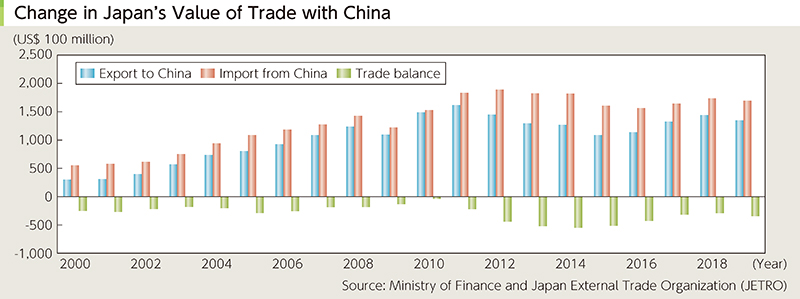
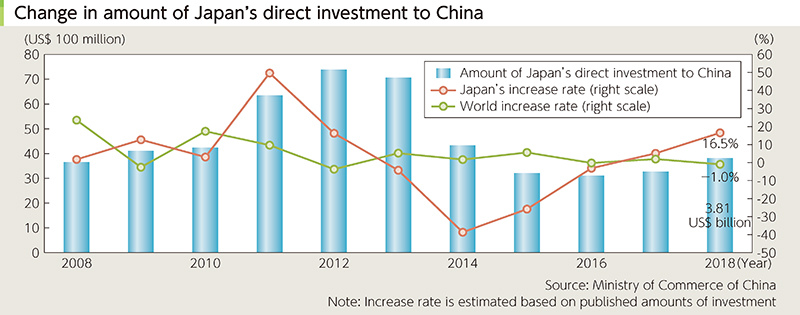
High-level visits were frequent and cooperative relations were also strengthened in the economic field in 2019. The First Japan-China Innovation Cooperation Dialogue (vice-ministerial level) was held in April. Japan and China introduced their respective innovation policies to each other, exchanged opinions on various exchanges and cooperation, and shared recognition on the importance of efforts in the field of intellectual property in both Japan and China to develop the environment for Japan-China cooperation in innovation. They explained their respective policies involving the field of intellectual property, and exchanged views on a variety of challenges, including: protection of trade secrets, elimination of concerns over forced technology transfer (e.g., recent trends surrounding the Regulations on Technology Import and Export Administration (TIER) and the Foreign Investment Law), and measures against pirated products. The Japan-China Economic Partnership Meeting (vice-ministerial level) was also held that month. At the meeting, Japan raised the issue of promoting trade and investment in accordance with international rules and practices to the Chinese side, in addition to improving the business environment in China, expanding exports of Japanese food, strengthening the protection of intellectual property protection, and strengthening measures against counterfeit products and pirated products. At the Fifth Japan-China Innovation Cooperation Dialogue (ministerial level) held also in April, a wide range of views were exchanged regarding topics such as macroeconomic policy, bilateral economic cooperation and exchanges, key cooperation under the Japan-China High-Level Economic Dialogue framework (Japan-China business cooperation in third countries and Japan-China Innovation Cooperation Dialogue), and regional and world economies and responses to global issues. At the Japan-China Summit Meeting that took place in June during President Xi Jinping's visit to Japan to attend the G20 Osaka Summit, the two leaders shared the view that the two countries would enhance mutually beneficial working-level cooperation based on international standards in areas that have potential, such as third country markets, innovations, protection of intellectual property, trade and investment including foods and agricultural products, finance and securities, medical and nursing care, energy conservation and the environment, and tourism exchanges, as well as further develop a free and fair trading system. From the perspective of further deepening Japan-China economic relations and the sustainable growth of the Chinese economy, Prime Minister Abe requested the opening up of the Chinese market and effective measures to establish a fair and equitable business environment, including the enhancement of intellectual property protection as well as the correction of forced technology transfer and market-distorting industrial subsidies. Furthermore, the Agreement on Social Security between the Government of Japan and the Government of the People's Republic of China (Japan-China Agreement on Social Security) came into effect in September. In previous years, employees, such as Japanese and Chinese corporate expatriates, temporarily dispatched from their companies to work in either Japan and China, have been obligated to join the pension systems in both Japan and China, and this posed the problem of their having to pay pension premiums twice. With this Agreement coming into effect, in principle, temporarily dispatched employees sent abroad for a period of five years or less will only have to pay into the pension system of their country of origin.
During the Japan-China-ROK Trilateral Summit in December, Japan held summit meetings with President Xi Jinping and Premier Li Keqiang of the State Council. The two sides shared the view on further strengthening cooperation in a variety of areas, including economic and practical cooperation between Japan and China. Prime Minister Abe expressed his desire to President Xi for both countries to make efforts to realize an environment for equitable competition and develop a free and fair trading system. Prime Minister Abe expressed his expectations to Premier Li for robust efforts toward enhancing the business environment, including by improving the implementation of legal systems, further opening up the market, and strengthening Japan-China financial cooperation.
There were active economic exchanges also in the private sector. The Japan-China Business Leader and Former High-Level Government Official Dialogue (Japan-China CEO Summit) was held in Tokyo in July. Also, during the visit to China by a mission from the Japan-China Economic Association, Keidanren (Japan Business Federation) and Japan Chamber of Commerce and Industry in September, views were exchanged between the executives of major companies in Japan and China, and meetings were held with officials of the Government of China including Premier Li Keqiang.
(C) Promotion of Mutual Understanding Between Japanese and Chinese People
(Current situation of people-to-people exchanges between Japan and China)
The number of Chinese visitors to Japan has continued to increase since 2013. The number of visitors in 2019 reached around 9.59 million people (estimated by the Japan National Tourism Organization (JNTO)), which was a record high. There was a further shift from group tourism to individual tourism, and there was also an increase in the number of repeat visitors as a result of relaxed visa requirements. It is thought that this is leading to diversification of the destinations and needs of visitors to Japan. In addition, with various factors such as the increase in the supply of seats due to new services and increased flights, and the effect of further relaxed visa requirements that started in January 2019, the number of people making mutual visits is expected to increase in the long run.
(Japan-China youth exchange, etc.)
During Prime Minister Abe's visit to China in October 2018, both he and Premier Li Keqiang shared the view that it is necessary to further expand two-way people-to-people exchanges, particularly exchanges between the young generation. The foreign ministers of Japan and China signed the “Memorandum on Enhancing Youth Exchange between the Government of Japan and the Government of the People's Republic of China,” and 2019 was designated as “Japan-China Youth Exchange Promotion Year.” The leaders shared the view on implementing young exchanges on a scale of 30,000 people over the following five years (see the Column on page 53).
In 2019, through JENESYS2019, the people-to-people exchange project including young people, about 460 Chinese people, including high school students and young adults, were invited to Japan. Young Chinese people who visited Japan experienced various cultures, lifestyles and the charms of Japan through school exchanges and tours of companies, while deepening mutual understanding with Japanese youth. They also actively exchanged opinions about what the future of Japan-China relations should be. Furthermore, under the Japan-China International Solidarity Project on Afforestation and Tree-Planting, about 1,400 people were invited to Japan for promoting understanding of Japan based on the theme of the “Three KAKEHASHI (Bridge)” Projects ((1) Regional exchanges (2) Youth exchanges, and (3) Culture and sports exchanges).
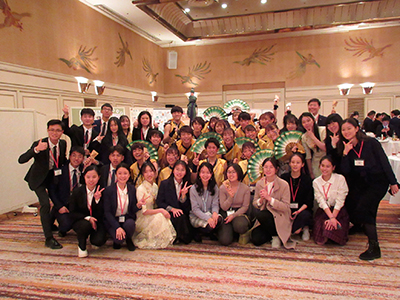 Second Japan-China 500-University Student Delegation (November 29, Tokyo; Photo: Japan-China Friendship Center)
Second Japan-China 500-University Student Delegation (November 29, Tokyo; Photo: Japan-China Friendship Center)During his visit to China in October 2018, Prime Minister Abe and Premier of the State Council of China Li Keqiang designated 2019 as the “Japan-China Youth Exchange Promotion Year” and concurred on promoting exchange between youths of the two countries in various fields in view of the importance of the role that youth exchange plays in bilateral relations. Consequently, events related to the “Japan-China Youth Exchange Promotion Year” were held between January 1 and December 31, 2019. There were about 240 accredited events, and the number of participants for the events held in both countries reached approximately 310,000. Many youths from the two countries, who will bear the future of Japan-China relations on their shoulders, deepened mutual understanding through exchanges in areas such as sports and culture, and the events produced significant outcomes. This column features four of the events in the “Japan-China Youth Exchange Promotion Year.”
1. Former head coach of the Japan national football team Mr. Nishino Akira's football exchange with youths from China
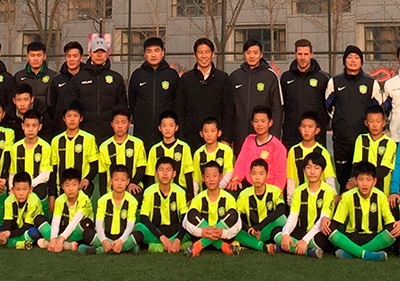 Exchange between Mr. Nishino Akira, former head coach of the Japan national football team and junior youth players from China (January 11, Beijing)
Exchange between Mr. Nishino Akira, former head coach of the Japan national football team and junior youth players from China (January 11, Beijing)From January 11 to 13, former head coach of the Japan national football team Mr. Nishino Akira visited Beijing and participated in an exchange event with junior youth players from Beijing Sinobo Guoan Football Club and students from Tsinghua University. This event was hosted by MOFA as a kickoff event for the “Japan-China Youth Exchange Promotion Year.” Football is a popular sport in China too, and the Chinese players and students were inspired by the exchange with Mr. Nishino, the then-head coach who led the Japanese team in the 2018 FIFA World Cup in Russia. The exchange event was also widely covered by the local press.
2. Opening ceremony for the “Japan-China Youth Exchange Promotion Year”
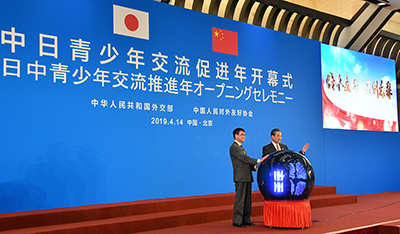 Opening ceremony for the “Japan-China Youth Exchange Promotion Year” (April 14, Beijing)
Opening ceremony for the “Japan-China Youth Exchange Promotion Year” (April 14, Beijing)On April 14, the opening ceremony for the “Japan-China Youth Exchange Promotion Year” was held at the Diaoyutai State Guesthouse in Beijing, China in the presence of Foreign Minister Kono and State Councilor and Foreign Minister Wang Yi. On the day of the event, approximately 250 university students from Japan and China, including Peking University, Tsinghua University, and Renmin University of China came together for the opening ceremony, and affirmed the importance of mutual trust and mutual understanding through direct exchanges.
3. Convention of the “Second Japan-China 500-University Student Exchange”
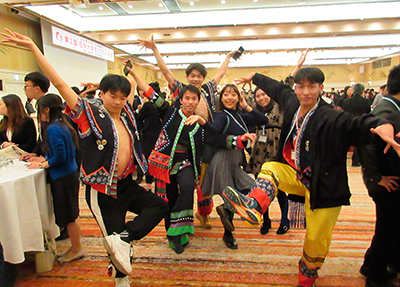 The “Second Japan-China 500-University Student Exchange” (November 29, Tokyo; Photo: Japan-China Friendship Center)
The “Second Japan-China 500-University Student Exchange” (November 29, Tokyo; Photo: Japan-China Friendship Center)The “Second Japan-China 500-University Student Exchange,” organized by the Japan-China Friendship Center, was held on November 29. This was a large-scale exchange event that brought together a delegation of 500 university students from Japan and China who represent the next generation (300 Chinese university students and 200 Japanese university students), and was the second time the event was held after its commencement last year. In addition to government officials from both countries, Mr. Tachibana Kenchi, a performer with the music group EXILE, and Ms. Liu Jingluo (Seira Ryu), a voice actor and manga artist who is bilingual in Japanese and Chinese, attended the student exchange event as special guests and livened it up. University students from Japan and China also put on song and dance performances, adding excitement to the youthful exchange through pop culture.
4. Convention of the “China-Japan Youth Friendly Exchange Conference”
On December 23, the Chinese People's Association for Friendship with Foreign Countries and the China-Japan Friendship Association co-hosted the “China-Japan Youth Friendly Exchange Conference” held at the Great Hall of the People in Beijing. Foreign Minister Motegi and State Councilor and Foreign Minister Wang Yi relayed their messages, and about 1,000 youths from both countries turned up at the venue for the event. Representatives of the participants presented their thoughts and impressions on their visits to the other country, and promoted the importance of mutual understanding.
Through the projects implemented under the “Japan-China Youth Exchange Promotion Year,” youths from the two countries strengthened their bonds. With their hearts full of the ideas and hopes that have sprouted through the mutual exchange, they are expected to play an active role in the future to form a new bridge between Japan and China.
(First Japan-China High-Level People-to-People and Cultural Exchange Dialogue)
At the Japan-China Summit Meeting with President Xi Jinping held during the G20 Osaka Summit in June, both leaders agreed to launch a high-level dialogue framework for people-to-people and cultural exchanges. Based on this agreement, Foreign Minister Motegi (Japanese side Chair) and State Councilor and Foreign Minister Wang Yi (Chinese side Chair) held the First Japan-China High-Level People-to-People and Cultural Exchange Dialogue in Tokyo in November. Both ministers discussed further strengthening exchanges in a variety of fields including youth, culture, sports, women, tourism, contents (such as video), and media.
 First Japan-China High-Level People-to-People and Cultural Exchange Dialogue (from left: Vice Minister of Culture and Tourism Zhang Xu, Minister of Education Chen Baosheng, State Councilor and Foreign Minister Wang Yi, Minister for Foreign Affairs Motegi, and Minister of Education, Culture, Sports, Science and Technology Hagiuda)
First Japan-China High-Level People-to-People and Cultural Exchange Dialogue (from left: Vice Minister of Culture and Tourism Zhang Xu, Minister of Education Chen Baosheng, State Councilor and Foreign Minister Wang Yi, Minister for Foreign Affairs Motegi, and Minister of Education, Culture, Sports, Science and Technology Hagiuda) (November 25, Tokyo)
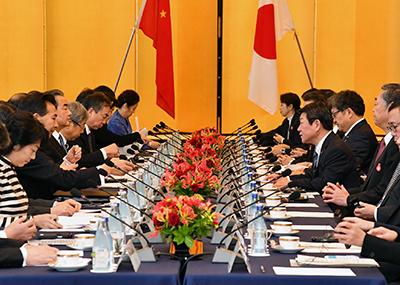 First Japan-China High-Level People-to-People and Cultural Exchange Dialogue (November 25, Tokyo)
First Japan-China High-Level People-to-People and Cultural Exchange Dialogue (November 25, Tokyo)The two sides shared the view on further promoting people-to-people and cultural exchanges, including sports exchanges, by making next year the “Japan-China culture and sports Exchange Promotion Year.”
In December, the Ministry of Foreign Affairs chose idol group Arashi to conduct public relations work as goodwill ambassadors for sports and cultural exchanges with China to promote the “Japan-China culture and sports Exchange Promotion Year” in 2020.
(D) Specific Pending Issues
(Situation surrounding the East China Sea)
In the East China Sea, Chinese Government-owned vessels continue to intrude into the Japanese territorial sea around the Senkaku Islands. Also, the Chinese military has been rapidly expanding and increasing its activities in quality and quantity at sea and in the airspace over the East China Sea. Furthermore, China continues unilateral development of resources in China's side of the geographical equidistance line in the maritime area pending delimitation between Japan and China, and has repeatedly carried out maritime researches without Japan's consent.
The Senkaku Islands are indisputably an inherent part of the territory of Japan in light of historical facts and based upon international law. Indeed, the Senkaku Islands are under the valid control of Japan. Thus, there exists no issue of territorial sovereignty to be resolved concerning the Senkaku Islands. From 1895, when Japan obtained territorial sovereignty over the Senkaku Islands by lawful means under international law, until the 1970s, when the islands became the focus of attention after it was suggested that there might be oil reserves in the East China Sea, China had not raised any objections to Japan's sovereignty over the Senkaku Islands. Moreover, China has never explained why it had not expressed objections until then.
Chinese Government-owned vessels continue to intrude into the Japanese territorial sea, recording 32 incidents during 2019 (the numbers were 19 in 2018, and 29 in 2017). In response to such unilateral attempts by China to change the status quo, the Government of Japan has repeatedly lodged strong protests and requested the withdrawal of Chinese vessels through diplomatic routes. With the determination to defend Japan's territory as well as territorial sea and airspace, Japan will continue to take a calm and resolute approach to the situation.
In addition, Chinese naval vessels and aircraft have also been accelerating their activities in the sea and airspace around Japan. In January 2018, a submarine and ship navigated into Japan's contiguous zone around the Senkaku Islands. We expressed serious concerns, issued a serious protest, and strongly requested that it would not happen again, through diplomatic routes. Furthermore, aircraft activities also continue to be active, and the number of times the Air Self-Defense Force had to scramble jets in response to Chinese military aircraft since autumn 2012 has remained high. In response to these recent activities by the Chinese military, Japan has been raising the issues in an appropriate manner through diplomatic routes.
Furthermore, China has been continuing its unilateral activities to develop natural resources while the Exclusive Economic Zone (EEZ) and the continental shelf between Japan and China in the East China Sea remain pending delimitation. The Government of Japan has confirmed 12 new structures built between June 2013 and May 2016, making a total of 16 structures including those confirmed before then, on the Chinese side of the geographical equidistance line. Such unilateral development activities are extremely regrettable, and every time such moves by China are detected, Japan has strongly requested China to cease its unilateral development and to immediately resume negotiations on the implementation of the “2008 Agreement” regarding the cooperation between Japan and China on the development of natural resources in the East China Sea. At the summit meeting between President Xi Jinping and Prime Minister Abe in June 2019, the two leaders shared the view of promoting and implementing the “2008 Agreement” regarding resource development in order to achieve the goal of making the East China Sea a “Sea of Peace, Cooperation and Friendship.”
Moreover, in recent years numerous activities by China to carry out surveys in the waters around Japan, including the East China Sea, without obtaining Japan's approval, or surveys that differ from those agreed upon have been confirmed.
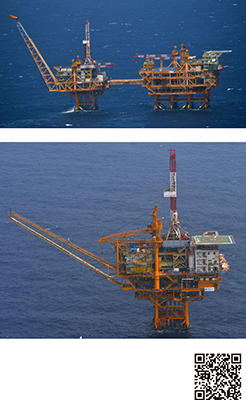 Chinese maritime structures confirmed to have been built near the geographical equidistant line between Japan and China (Photo: Ministry of Defense)
Chinese maritime structures confirmed to have been built near the geographical equidistant line between Japan and China (Photo: Ministry of Defense) See the link below for details: https://www.mofa.go.jp/a_o/c_m1/page3e_000356.html
In order to deal with these concerns appropriately, both Japan and China have been promoting dialogue and exchanges between the authorities concerned. During the visit to Japan by Premier Li Keqiang in May 2018, the discussions on the Maritime and Aerial Communication Mechanism between the defense authorities of Japan and China had been concluded after 10 years of consultations, and in June the Mechanism began to be utilized. This is highly significant for promoting mutual understanding between both countries and avoiding and preventing accidental collisions. Also, during Prime Minister Abe's visit to China in October 2018, the Japan-China Maritime Search and Rescue (SAR) Agreement was signed. The Agreement creates a legal framework regarding Japan-China cooperation for the maritime search and rescue field, and is expected to enable smoother and more efficient search and rescue activities. In addition, the Japan-China High-Level Consultation on Maritime Affairs was held on May 2019 in Otaru, Hokkaido.
As Prime Minister Abe has repeatedly stated at Japan-China Summit Meetings, true improvement in Japan-China relations cannot be achieved without stability in the East China Sea. It is highly meaningful from the perspective of building trust and bolstering cooperation for diplomats from both countries to meet in person and exchange opinions frankly, such as at the Japan-China High-Level Consultation on Maritime Affairs or other discussions between related authorities of both countries. The Government of Japan will strive to improve relations with China, while asserting Japan's position on individual issues through steady dialogue and continued bolstering of communication, in an effort to turn the East China Sea into the “Sea of Peace, Cooperation and Friendship.”
(Abandoned chemical weapons issue)
The Government of Japan, in accordance with the Chemical Weapons Convention (CWC), has been working on the destruction of chemical weapons abandoned by Japan in China. In 2019, on-site investigations, and excavation and recovery operations were carried out in various locations across China. The destruction works in Haerbaling District in Dunhua, Jilin Province and also in Harbin, Heilongjiang Province have been carried out. In total, about 58,000 abandoned chemical weapons have been destroyed as of December.
(Cases of Detainment of Japanese Nationals)
In regard to cases of detainment of Japanese nationals, the Government of Japan has been working toward their early release at various occasions between Japan and China, including summit meetings. One Japanese national detained in September 2019 was released in November. Since then, the Government of Japan has strongly requested at all levels and at every occasion to the Government of China, including at talks between Prime Minister Abe and President Xi Jinping in December 2019, to ensure transparency in executing the law and the judicial process, properly safeguard the rights of Japanese nationals, ensure impartial justice, and provide humane treatment.
(Japanese food import restrictions issue)
Regarding the import restrictions placed on food and agricultural products from Japan by the Government of China, Japan has taken every opportunity to urge the Chinese side to carry out an evaluation based on scientific evidence, and has lobbied for the abolition and relaxation of the restrictions. The occasions in which this issue was raised include the Japan-China Summit Meeting in June, Japan-China Foreign Ministers' Meeting in September, the courtesy call to Prime Minister Abe by Chinese Vice President Wang Qishan in November, and summit meetings with Prime Minister Abe and President Xi Jinping and Premier Li Keqiang in December. With respect to the resumption of Japanese beef exports, the “Japan-China Animal Health and Quarantine Agreement,” one of the important steps for resuming exports, was signed on November 25, and the Government of China announced the lifting of a ban on imports relating to bovine spongiform encephalopathy (BSE) and foot-and-mouth disease effective December 19. On October 24, the Government of Macau announced that it would lift the ban of imports subject to the attachment of documents specified by the Government of Macau with respect to produce, fruit, and dairy products from nine prefectures (Miyagi, Ibaraki, Tochigi, Gunma, Saitama, Chiba, Tokyo, Niigata, and Nagano).
(2) Taiwan
A Domestic Affairs
On January 11, 2020, Taiwan conducted its presidential election and an election for the Legislative Yuan, which are held every four years. Although the ruling DPP were defeated in the local elections held in November 2018, the incumbent President Tsai Ing-wen, who, since the summer of 2019, had greater support in public opinion polls than Han Kuo-yu of the largest opposition party, the Kuomintang, was re-elected with a higher number of votes than any past presidential election winners.
In the election for the Legislative Yuan, the DPP lost seats but still managed to maintain a majority by claiming 61 of the 113 seats while the Kuomintang came in second with 38 seats. The Taiwanese People's Party, launched in August 2019, came in third with five seats. In addition, the real GDP growth rate in 2019 increased by 2.71% year-on-year.
B Cross-strait Relations and Foreign Affairs
Since the inauguration of the Tsai Ing-wen administration, it can be seen that the direct cross-strait exchanges through the official route (Chinese side: Taiwan Affairs Office of State Council, the Association for Relations Across the Taiwan Strait, Taiwan side: Mainland Affairs Council, the Straits Exchange Foundation, Mainland Affairs Council) have been discontinued. Under these circumstances, President Xi Jinping delivered an important speech in January 2019 in which he called for cross-strait unification under “one country, two systems,” but President Tsai Ing-Wen declared that an absolute majority of Taiwanese people would not accept “one country, two systems.”
Taiwan was an observer at the World Health Organization (WHO) general assembly from 2009 to 2016, but has not been able to participate since 2017, and has also not been able to participate in the general assembly of the International Civil Aviation Organization (ICAO) and other international organizations. Furthermore, Taiwan is only able to participate in some technical meetings and expert meetings (Taiwan participates in the WHO expert meeting on COVID-19 in 2020).
Following São Tomé and Príncipe in 2016, Panama in 2017, Dominican Republic, Burkina Faso, and El Salvador in 2018, and the Solomon Islands and Kiribati in September 2019, who have severed diplomatic relations with Taiwan and established or re-established diplomatic relations with China, there are a total of 15 countries who have diplomatic relations with Taiwan (seven countries have cut diplomatic relations with Taiwan since the inauguration of the Tsai Ing-Wen administration).
C Japan-Taiwan Relationship
For Japan, Taiwan is an extremely crucial partner and an important friend, with which it shares fundamental values such as freedom, democracy, basic human rights, and the rule of law, and enjoys close economic relations and people-to-people exchanges.
The relationship between Japan and Taiwan is maintained on the basis of working relations at the non-governmental level in accordance with the 1972 Joint Communiqué between Japan and China.
The sentiments of Japanese and Taiwanese citizens toward each other are generally favorable. In a survey conducted in February 2019 by the Japan-Taiwan Exchange Association, a private Japanese agency, 70% of Taiwanese respondents said they “felt close to Japan” or “relatively felt close to Japan.”
Reflecting such favorable sentiments toward Japan, the number of visitors to Japan from Taiwan in 2019 exceeded 4.89 million, marking a record high and demonstrating close people-to-people exchanges.
From April, the maximum number of visas under the Japan-Taiwan Working Holiday system was also expanded from 5,000 to 10,000.
Furthermore, the Japan-Taiwan Exchange Association and Taiwanese private agency, Taiwan-Japan Relations Association, signed the Memorandum on Exchange and Cooperation in the Field of Environmental Protection, the Memorandum for the Mutual Cooperation in the Field of Patent Prosecution (PPH), the Memorandum for the Mutual Cooperation in the Field of Industrial Design Priority Document Exchange (Design PDX), and the Memorandum of Promoting Cooperation on the Import-Export Organic Foods in October.
Japan has consistently supported the participation of Taiwan as an observer in the WHO General Assembly.
On the other hand, Taiwan has continued to impose import restrictions on Japanese food products after the Great East Japan Earthquake, and Japan has repeatedly strongly requested the removal and relaxation of the restrictions on the basis of scientific evidence.
(3) Mongolia
A Domestic Affairs
Prime Minister Khurelsukh, who was elected as Prime Minister in October 2017 and Chairman of the ruling Mongolian People's Party in November 2017, has maintained a stable administration through his second year in office in 2019. He has made efforts to steadily implement the Extended Fund Facility (EFF) agreed upon with the International Monetary Fund (IMF), and the nominal GDP growth rate in 2019 reached 5.1%, showing steady improvement of Mongolia's macroeconomic indicators.
B Japan-Mongolia Relations
Mongolia is an important regional partner sharing universal values with Japan, so Japan will continue to strengthen friendly ties with the country in a “Strategic Partnership,” so that the relationship will truly be mutually beneficial.
In June 2019, Foreign Minister Kono visited Mongolia for the first time in nine years as foreign minister. In addition to meeting with Foreign Minister Tsogtbaatar, Foreign Minister Kono paid a courtesy call to President Battulga and Prime Minister Khurelsukh. In August, Foreign Minister Kono held a foreign ministers' meeting with Foreign Minister Tsogtbaatar in Thailand on the margins of the ASEAN Foreign Ministers' Meeting.
In September, Prime Minister Abe, who visited Vladivostok (Russia) to attend the Eastern Economic Forum, held a summit meeting with President Battulga for the third consecutive year.
In October, Prime Minister Khurelsukh visited Japan to attend the Ceremony of the Enthronement of His Majesty the Emperor, and held a summit meeting with Prime Minister Abe.
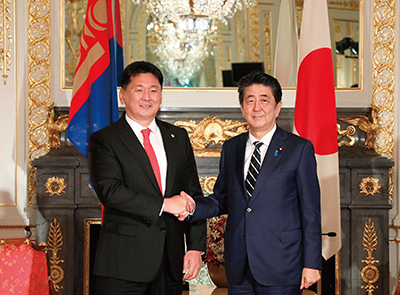 Japan-Mongolia Summit Meeting with Prime Minister Khurelsukh (October 21, Ulaanbaatar, Mongolia; Photo: Cabinet Public Relations Office)
Japan-Mongolia Summit Meeting with Prime Minister Khurelsukh (October 21, Ulaanbaatar, Mongolia; Photo: Cabinet Public Relations Office)In December, Minister of Defence Enkhbold visited Japan through a ministerial-level invitation program of the Ministry of Foreign Affairs, and held a defense ministers' meeting with Minister of Defense Kono, and also met with Foreign Minister Motegi.
 Talks between Minister for Foreign Affairs Motegi and Minister of Defence of Mongolia Enkhbold (December 2, Tokyo)
Talks between Minister for Foreign Affairs Motegi and Minister of Defence of Mongolia Enkhbold (December 2, Tokyo)In addition, the Fifth Consultative Meeting between Authorities for Foreign Relations, Security and Defense of Mongolia and Japan was held in Tokyo in April.
Through this series of active exchanges, Japan and Mongolia have affirmed their intents to develop the “Strategic Partnership” and contribute to the peace and stability of the regional and international communities. Furthermore, the two countries confirmed they would cooperate to ensure the smooth opening of the New Ulaanbaatar International Airport, recognizing the fact that the New Ulaanbaatar International Airport LLC, jointly established by the Japan Business Federation and the Mongolian public corporation, signed a 15-year concession agreement for the airport with the Mongolian National Development Agency in July.
Japan will continue to strengthen bilateral relations steadily in accordance with the Japan-Mongolia Mid-term Action Plan for a Strategic Partnership (2017-2021) and make efforts to develop the “Strategic Partnership” between Japan and Mongolia.

